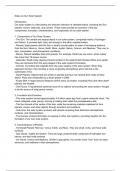Summary
Summary Behavioural Finance
- Course
- Financial Management 244
- Institution
- Stellenbosch University (SUN)
Notes/lecture summary on Behavioural Finance, done in Financial Management 244 at Stellenbosch University from the 2020 academic year.
[Show more]




